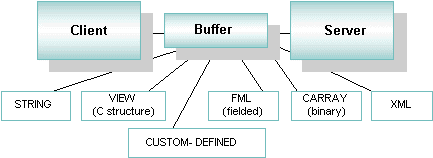


|

|
|
|
|
Using Typed Buffers in Your Application
All communication in the BEA Tuxedo system is transmitted through typed buffers. The BEA Tuxedo system offers application developers the choice of many different buffer types to facilitate this communication. All buffers passed through the BEA Tuxedo system have special headers, and must be allocated and freed through the BEA Tuxedo ATMI (tpalloc(), tprealloc(), and tpfree()).
Different Types of Buffers
The typed buffers facility allows for generic well-defined processing to be implemented once a buffer type is shared across any type of network and protocol and any type of CPU architecture and operating system supported by the BEA Tuxedo system. The advantage of typed buffers in a distributed environment is that they relieve your clients and servers from the details of preparing data to be transferred between heterogeneous computers linked by various communications networks. This affords an application programmer time to concentrate on their business logic, instead of focusing attention on writing this facility into their own programs. See Also

|

|
|
|
|
Copyright © 2001 BEA Systems, Inc. All rights reserved.
|